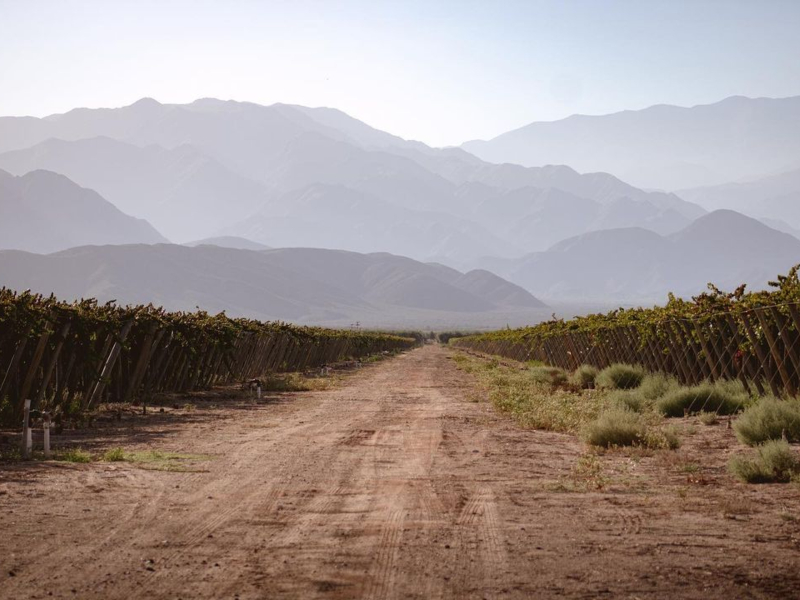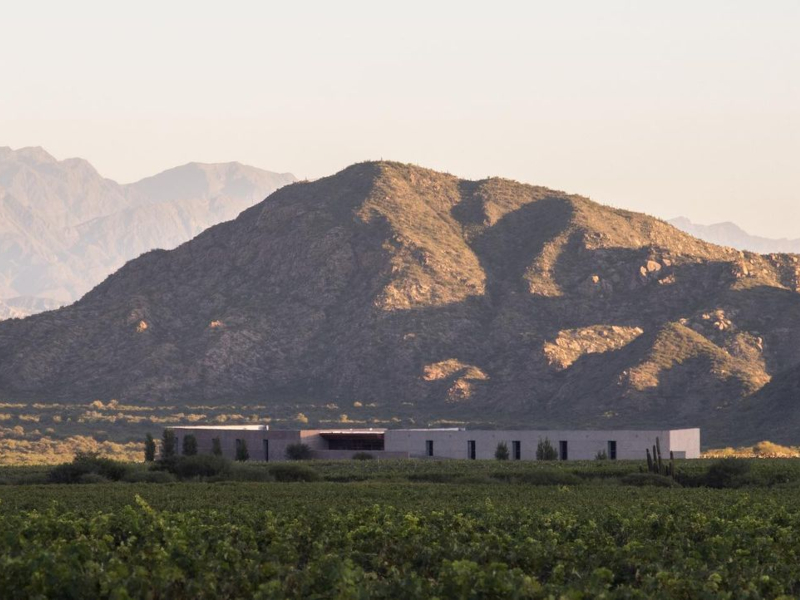Rolling mountains, stunning trails and the Famatina Valley: Chilecito, which is 120 miles from the provincial capital in the Cuyo area, contains plantations of walnuts, orchards, olive groves and vineyards. It is home to 17 wineries, most of which are located in Chilecito, although they can also be found in Villa Unión and Famatina, with options for wine tourists ranging from boutique operations to large wineries alongside local restaurants, hotels and inns.
La Rioja and its oenological landscape

La Rioja, which is also home to wineries in the areas of Anillaco, Aminga and Sanagasta, has a surprising amount of hectares under vine at 6000 between the Velasco and Famatina sierras at heights ranging from 2300 to 6000 feet above sea level. Notable varieties grown here include Torrontés Riojana, which is native to the province, Bonarda, Malbec, Cabernet Sauvignon and Syrah.
With 3.26% of the vineyards of the country, as Mario González, President of the Viticultural Corporation of Argentina (COVIAR) and a member of the Cooperativa La Riojana – the largest producer in the province – explains, it has “the most hectares planted with Torrontés Riojano and proportionally the most hectares certified as Organic and Fair Trade.” With a growing wine tourism scene, the first vineyards were planted in Anillaco, to the north of the province, where monks started a craft industry that is now concentrated further south in Chilecito, producing wines that have won awards in Argentina and overseas.
“The first vineyards in the province date back to 1617, this is where Argentine Torrontés was born. In the La Puerta Valley today we’re a model for development with wines that stand out for offering value for money, sustainable production processes and commitment to the environment. We certify our sustainability to meet our international customers’ demands,” says Julián Clusellas, President and CEO of Bodega Valle de la Puerta.
La Rioja and Riojan Torrontés

The Torrontés grape was created by a natural crossing of Muscat of Alexandria from Spain and Criolla Chica. In the vineyards, you can find Torrontés Mendocina, Torrontés Sanjuanina and Torrontés Riojana, but it’s the latter that is most distinctive. Its adaptability makes it the most widely planted in the province and other wine producing regions.
The Doctor of Oenology Rodolfo Griguol, Head of Oenology at the Cooperativa La Riojana, is considered the “father of Torrontés”, and has studied the variety for the last five years in partnership with the Universidad Nacional de Chilecito and the Universidad Juan Agustín Maza. He was responsible for documenting the changes in the variety across different terroirs, the production processes employed until then and the improvements that allowed the wine’s rustic characteristics to be smoothed out.
But it was when he was studying the yeasts used during fermentation that he discovered the key to producing a refined Torrontés; an aromatic, fruity, delicate and very fresh white. Over 8000 clones of native yeast and 15,000 clones of winery yeast were analyzed and one – LRV 945 – was identified as being the first active ecotypical dry yeast used in winemaking in Argentina.
Today, Torrontés is a wine that offers spring aromas of tropical fruit and flowers, a worthy symbol of the innovative winegrowing scene of La Rioja where it accounts for almost 30% of the surface area under vine, some at biodynamic vineyards like Rayo de Luna – run by Cooperativa La Riojana – which earned certification in 2010 for its plantations of Torrontés, Malbec, Syrah, Bonarda and Pinot Gris.
Tradition, innovation and a vision for the future

“My family has been involved in winemaking for years, although we did it on an artisanal scale. The farm, the fields, Anguinán and the family, I grew up with all that, it shaped my path. The place where I grew up is now once again my place in the world,” says Macarena Herrera, who runs the La Macarena project in Anguinán, four miles from the town of Chilecito. The winery is building on the work of Isidoro, her grandfather, who started to grow vines in Famatina in the 70s to honor his father, who migrated from Lebanon.
According to Herrera, a member of a new generation looking to put the province on the map of wine regions to be visited by professionals and wine lovers alike, “La Rioja has enormous potential, although there’s still plenty of work to be done on building up the industry. Riojan wines are as good as those produced in Mendoza or Salta.”
In La Rioja, hospitality is a major aspect of the local culture. If the plan is to visit the Chilecito area and get to know the local culture, several wineries have tourist facilities, including Cooperativa La Riojana, Chañarmuyo, Valle de la Puerta, Haras San José and Quebrada de las Flechas. In the “Costa Riojana” you’ll also find San Huberto and Las Carolinas in Anillaco, Bodega de Aminga in Aminga, and Vista Larga in Sanagasta.
The producers of La Rioja have chosen to honor their history and past generations, continuing a legacy but also creating a clear vision for the future based around their flagship variety, Torrontés Riojano, with a philosophy that includes protecting the local environment and producing wines that will proudly represent the province across Argentina and overseas.



